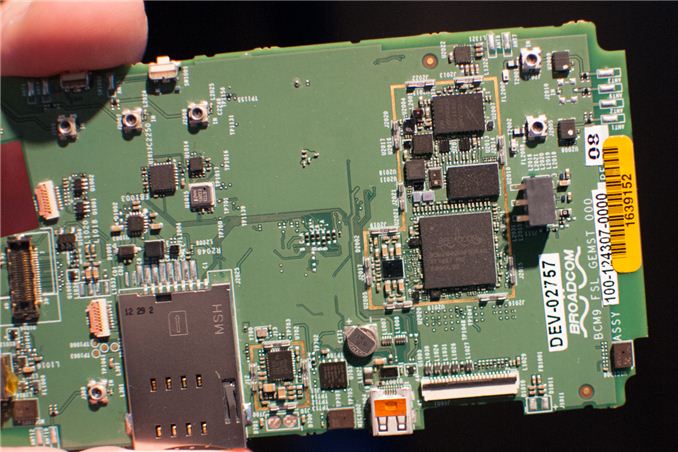A Look at Broadcom's BCM21892 LTE Baseband at MWC
by Brian Klug on February 27, 2013 3:42 AM EST
Yesterday we stopped by Broadcom to look at their newly announced BCM21892 LTE baseband, which we saw teased previously at CES doing a VoLTE call. If you're not famliar with the details of Broadcom's first LTE baseband, it's a 3GPP Release 10 modem supporting all the 3GPP air interfaces (GSM/EDGE, WCDMA, TD-SCDMA, LTE) with Category 4 LTE support, support for 10+10 MHz carrier aggregation, integrated 8 port transceiver into the baseband package, and built on a 28nm HPm process.
| Broadcom's LTE Baseband | ||||
| BCM21892 | ||||
| Air Interfaces | GSM/EDGE, WCDMA, LTE-A, TD-SCDMA | |||
| 3GPP Release | Rel. 10 (LTE-A) | |||
| HSPA+ Category | Cat. 24, DC-HSPA+ 42.2 Mbps | |||
| LTE |
Cat. 4, LTE-A 150 Mbps Downlink / 50 Mbps Uplink 2x2 MIMO |
|||
| Voice | VoLTE, CS WCDMA/GSM voice | |||
| Process | 28nm HPm | |||
| Package | Plastic(?) with integrated DRAM and 8-port Transceiver | |||
| Extra | External PMIC, "35% smaller required implementation area," envelope tracking supported | |||
There's nothing new about the feature set, but it was nice to see BCM21892 silicon working and demonstrating all of the available features we heard about in the announcement working. I recorded a video of the entire demo walkthrough which I'd encourage you to watch if you're interested. The booth contained both BCM21892 working on a few demo boards, as well as integrated with their own platform form factor reference design which runs the full house of Broadcom silicon - WLAN/BT Combo, SoC, and GPS.
Broadcom demonstrated both full 150 Mbps UE Category 4 rates on a cabled up demo, 10 + 10 MHz carrier aggregation on Band 17 and 4 (AT&T's configuration) switching in and out the band 4 carrier, and envelope tracking support working on the BCM21892.
















8 Comments
View All Comments
jamyryals - Wednesday, February 27, 2013 - link
Sweet demos, thanks for posting the video Brian.Would you do a post (or talk about it on the podcast) that better explains the power envelope tracking technology? That is very interesting.
xaueious - Wednesday, February 27, 2013 - link
Looks like this is one of the top competitors to Qualcomm's solution.Nehemoth - Wednesday, February 27, 2013 - link
How it does compare against the new introduced XMM 7160xaueious - Wednesday, February 27, 2013 - link
Marketing says Broadcom has Cat 4 vs Cat 3 for Intel. It might have a better power envelope, which Intel isn't known for excelling in.iwod - Thursday, February 28, 2013 - link
I want to know this too. Baseband has went from Qualcomm as the only 3rd party provider ( Others are used in their own product ) to many choice on 3rd party solutions.ST-E Thor, Broadcom, Intel, Would be nice if Anand does an article on it.
Krysto - Thursday, February 28, 2013 - link
Why is the upload speed always so much smaller than the download one? Is it a technical issue, as in it's harder to make the upload speed as fast or is it just laziness/desire to cut development cost. So they're like: "we've achieved 50 Mbps with it so far - let's not bother increasing that, and just ship it as it is".hfish - Monday, March 4, 2013 - link
because in you normal digital life you are more prone to download things than to upload them, so it seems pretty fair to have more bandwidth dedicated to downlink...even in ADSL UL gets the noisy and smaller part of the spectrum, compared to DL
dhruvz - Thursday, May 23, 2013 - link
this is because of power amp limitations on device side. If you can power up your using a diesel generator, then you can have those awesome upload speeds as well. :)the upload speeds are dependent on lot of things, power/battery on device side is one of the main reasons.